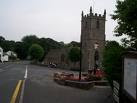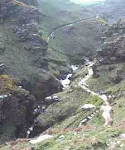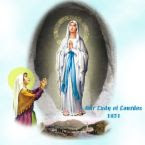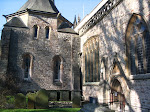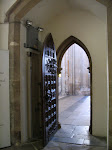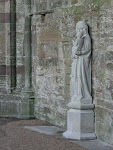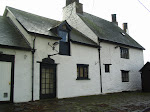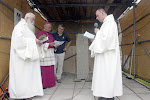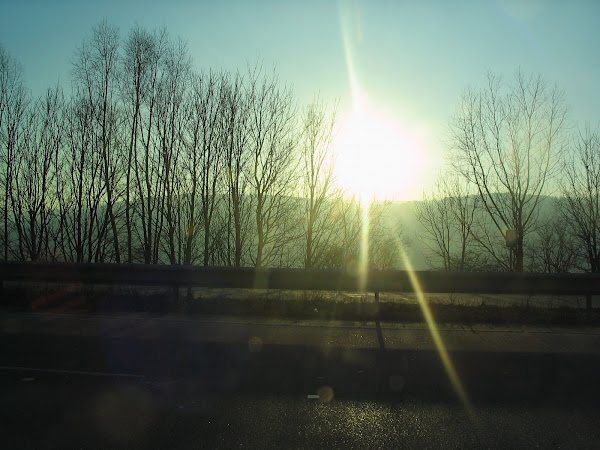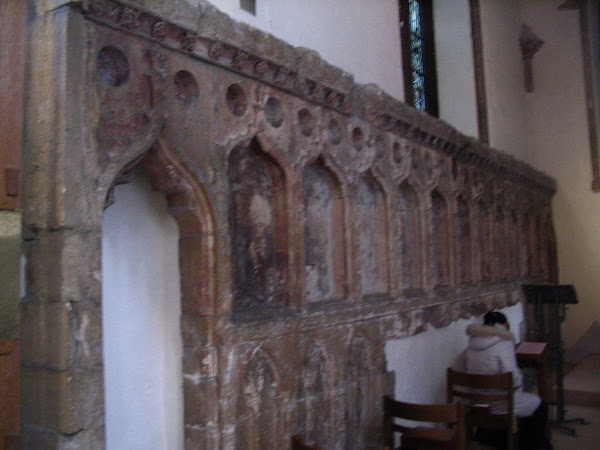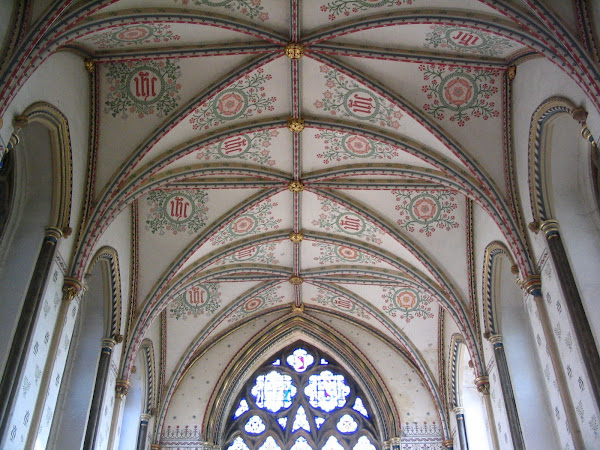



 _____________________________________________________
_____________________________________________________BRYCHAN BRYCHEINIOG
The King of Brecon, one of the holiest 3 families in Wales, decended , according to Welsh annals from the family of Joseph of Arimathea and the family members of the Virgin Mary, who had been granted land at Garthmadrun (now Talgarth) according to Welsh sources.Joseph was a tin merchant and had accompanied the Empoeror Vespasian on his many trips to Britannia. They returned, sent by St Peter, travelling to Gaul with St Philip, who sent them on to Britannia. There was considerable antipathy to the families of anyone connected with Jesus at this time, and so it is likely that they came with Joseph. Interestingly, whilst the holy men desiring hermitage had gone to land given by Archiviragus, brother of Caractacus and King of the Demetiae, known as Ynys Witrin (The Island of Glass) or Glastonbury. Joseph's extended family lived at Talgarth and married into the local royal family(of Irish extraction!), but in the early years the genealogy shows many Jewish names.Parishaw in the Black Mountains for example is from Pater Ishow (Issui in Welsh) Or Father Esau, believed to be from that family.Perhaps Issey, daughter of Brychan was also from the female form of the name, and commemorated at nearby St Issey on the way to Padstow.
Brychan was the father of numerous holy children, although it is felt these may have been grandchildren as well, Amongst these children are many of the Cornish and Welsh Saints. We have seen how St Paul inspired chastity in women and how many Christian women, for the first time saw that they need not marry and could not be forced to-many undergoing hideous tortures for the faith, like St Thekla for example, Paul’s disciple, who was tortured for not marrying a man chosen by her parents.
Many followed her example . St Winifred of Wales is one such example as are the saints all over the church, St Lucy,St Perpetua. Our own St Tecla of Gwent on her tiny island near what is now the old Severn Bridge was another.
Unusual in Brychan’s court, was that he encouraged his children to set up llans all over the district. Under his advisor St Brynach, a priest who had arrived via Ireland from the Holy Land, his children were carefully brought up as Christians.
He had numerous children (many of whom we have already heard of here on this site) In the true manner of Old British saints, however ,they wandered around from place to place (white martyrdom-to where God would lead them) until they found their ‘green martyrdom’sanctified the area of their ‘llan’ and settled there.
Brychan’s children in Cornwall included
ADWEN(Advent) CLETHER,KEW,OUDICEUS(Euddogwy, her brother and nephew of Teilo) ENDELIENTA ,
(St Endellion)ISSEY (St Issey)KERIA (Egloskerry)CEYNA (St Keyne) MABENA, (St Mabyn) MINVER (St Minver)MORWENNA,TEATH, and of course some sons, FINBAR and OUDICEUS.Others we have heard of in Wales are Tydfil, Tegwedd and St Gwladys in Newport. It is wonderful to see this stained glass window paying tribute to this holy King.I have written about Brychan before.
Donors of the Windows
The different windows were donations from local families . Borlase, Martyn, Motton, Callaway and Tubbe families.
Unique Mediaeval St George Window
Twelve scenes in the west window of the north aisle describe the life of St. George. They depict the Eastern Church’s recorded martyrdom accounts as a Christian Roman soldier born in Palestine this window is of unique interest as incidents are not found elsewhere nowadays. St George was always shown holding the flag of the Paschal Sacrifice , the red blood on the pure white flag, representing the Lamb of God. In grasping this flag, he was himself taking the Martyrdom for the sake of Christ.The dragon he fought was probably a metaphor for the enemies of Christ. The flag accepted by the Crusaders, who spread a legend of his fighting a dragon as many of then had to as so many of whom died in droves trying to protect the Christian pilgrims to the Holy Places. St George was their inspiration
The Paschal Flag became the English Flag.
It is worth pointing out that St Piran is the patron saint of Cornwall, but had long been administered from England since Norman times and later Wales too became annexed to England and the Welsh language to be 'extirped'
George was born to a Christian noble family during the late third century around AD 275 and AD 285, in Lydia Palestine. His father Geronzio was a Roman army official from Cappodocia and his mother from Palestine. They were both Christians and from noble families of Anici (can not be defeated), so by this the child was raised with Christian beliefs. They decided to call him George meaning "worker of the land".
George offered himself as a soldier to Diocletian, who accepted him as Geronzio had been one of his finest soldiers and by his late 20s, George was a Tribune and stationed at Nicomaedia.
In the year AD 302, Diocletian (influenced by Galerius) issued an edict that every Christian in the army should be arrested and every soldier offer sacrifice to the Roman gods.
George objected and with the courage of his Faith approached the Emperor and tore up the edict. Diocletian was upset, not wanting lose his best Tribune and son of his best official, Geronzio. George loudly renounced the Emperor's edict, and in front his fellow soldiers and Tribunes he claimed himself to be a Christian and declared his worship of Jesus Christ. Diocletian tried to make George change his mind, even offering gifts of land, money and slaves if he made the sacrifice to the Pagan gods. The Emperor made many offers, but George would not accept.
Having made this edict, Diocletian was left with no choice but to have the saint executed for his refusal. Before the execution George gave his wealth to the poor and prepared himself. After many torture sessions,(which included being lacerated on a wheel of swords, he was miraculously resuscitated three times, George was indeed, as shown in the window of St Neot, executed by decapitation before Nicomedia's city wall, on April 23, 303AD, the same year as St Julius and St Aaron)of Caerleon) and St Alban (of Verulamium)died.
. A witness of his suffering convinced Empress Alexandra and Athanasius, a pagan priest, to become Christians as well, and so they joined George in martyrdom. His body was returned to Lydda for burial, where Christians soon came to honour him as a martyr there in Palestine.So not a legend , but a real Martyr and Protector of England.
Back to the St Neot Windows
The guide to the church building states
‘The finest and least restored window, the Creation Window, is at the east end of the south aisle and is full of delightful things representing the Creation (including the newly created bird flying off the tip of His finger), the Fall, Cain and Abel and lastly Noah politely doffing his cap to God as he receives his instructions, while the first window in the south aisle represents the story of the Flood and Noah’
Underneath are the laity imploring ‘Ora Pro nobis’ from kneeling figures dressed in 15th century or so costumes. Only two parish churches in Britain have complete sets of stained glass designed for them –one at Fair ford in Goucester and here at St Neots.The earliest three windows are from 1480 and the last around 1539, which must have been at the date of the taking of church property to form the new ‘Church of England’ by Henry VIII.
It appears the remoteness of the church spared it from the army of Oliver Cromwell who usually destroyed stained glass if they could.
The New Glazing
In 2004, Richard Grylls, the present patron, engaged Arthur Bradley to replace the frosted window at the west end of the church, which obscured the belfry, with a new etched glass screen. The new window contains etchings of a dove, mirroring the dove over the baptismal font, together with fruits of the vine, and wheat from the fields, as well as a porcupine – a symbol from the Grylls family crest, and denoting both plenty and realisation of hopes. A beautiful addition to a fabulous Church.
In the Churchyard
Here in the churchyard was a lantern cross which appears to have had the figure of St Neot on one of the panels and possibly the Blessed Virgin, though truth to tell it shows more signs of weathering than the one I saw at Patrishaw in Gwent, in a lot better state of repair. Nevertheless this cross had been put up again, traditionally a place where visiting preachers or Newsgivers would stand whike addressing the local population.
The Mills as the source of local industry
Travelling along we went past a number of Mills which formed the earliest occupations of the local people-The Trago Mills retail outlet is a development of one of those mills, probably a money spinner in Mediaeval times!
Autumn Colours
The autumn colours were vibrant and startling and trees and woodland inviting in the summy monets but menacing in the dark gloomy moments. St Neots was situated in the area of Warleggan which was evocative of the Poldark TV series.
Return
As we returned to Tintagel, we passed Dozmary Pool, lying undramaticall in the Moor. This was where the legend of the 'arm in white samite'appeared to the earlier 'King Arthur' in Arthurian Legend. I ave written about Arthrwys, the real 'Dux Bellorum' before, but here is where local tradition places the legend. We also passed by the temple Church, home of the Templars until their cruel suppression.Was ever a more unjust punishment, by evil Philip the Fair of France? This Church is dedicated to St Catherine a popular Mediaeval saint, who died broken on a wheel, the rather sick nameing of a corresponing firework 'The Catherine Wheel' on bonfire night.
This A30 is also the site of 'Jamaica Inn', unfortunately nowhere near the sea, but there was also the Daphne du Maurier exhibition and a restaurant and inn with standard food.Frenchman's Creek is not far way and Cornwall was also the Cornish setting for the novel 'Rebecca'.
All in all, a most interesting day.




















